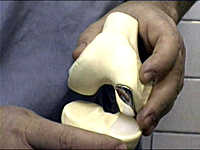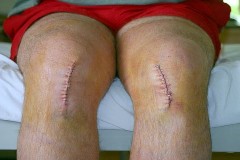Partial / Uni-compartmental / Unicondylar knee replacement is performed for partial knee arthritis.
Partial Knee replacement guide
Partial Knee Replacement
Do you need a partial knee replacement?
Osteo-arthritis usually affects one of the three compartments of the knee. It begins in the inner compartment at first. At a later stage the damage spreads to involve the knee cap. Finally the outer compartment is involved. Rarely the damage may begin in the outer compartment in patients with knock knees.
Patients with symptomatic partial arthritis may benefit from a partial knee replacement. In many patients since the arthritis starts in the inner half, I replace the inner half alone. If the outer half is affected then it can be replaced.

To be eligible for a partial knee, the patient should fulfill three criteria,
a) The inner half alone should be affected
b) The ACL should be intact
c) The deformity should be mild not exceeding 15 degrees of varus

Two groups of patients may benefit from a Uni-condylar knee
1) Patient in their fifties with partial arthritis in whom a Uni-condylar knee replacement can postpone a TKR by ten to fifteen years.
2) A patient in the eighties for whom this is the only operation that will be required.
The advantages of a partial knee replacement are
1) Less morbidity. The operation can be done through small incisions as big as 3 inches.
2) Less blood loss occurs as Healthy bone and cartilage is not damaged during the surgery.
3) The range of movement is almost like a normal knee. Fig shows small sized incisions for a partial knee replacement.
4) Quicker recovery as there is less post operative pain due to the small incision.
5) Knee feels more normal as the ligaments are preserved.
The Oxford knee is the uni- condylar knee with the longest follow up. I was the first surgeon to perform simultaneous bilateral Oxford knee replacements in 2005.
If you think that a partial knee replacement is the right procedure for you, please e mail us at drvenkat@kneeindia.com.
